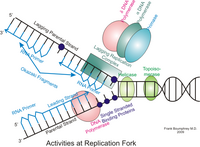
Photo from wikipedia
Jerard Hurwitz (photo courtesy of Memorial Sloan Kettering Cancer Center) The biochemistry community lost a true giant when Jerry Hurwitz passed away on January 24 at age 90. In a… Click to show full abstract
Jerard Hurwitz (photo courtesy of Memorial Sloan Kettering Cancer Center) The biochemistry community lost a true giant when Jerry Hurwitz passed away on January 24 at age 90. In a research career spanning seven decades, Jerry contributed profoundly to the field of molecular biology. His laboratory established the biochemical foundations for the central dogma via the discovery, purification, and characterization of the enzymes that catalyze mRNA synthesis, DNA replication, and nucleic acid modification and repair. His series of landmark papers concerning the ‘‘directing role of DNA in RNA synthesis’’ (1960–1966) embraced the discovery of E. coli RNA polymerase, the purification of the enzyme (Furth et al., 1962), the demonstration that rNTPs are the precursors for RNA synthesis, and (most importantly) that the RNA produced is a direct copy of the genetic information in the DNA template (Hurwitz et al., 1962). He showed that RNA polymerase initiates de novo so that the primary transcript retains a 50-triphosphate end and that chain elongation proceeds in the 50-to-30 direction (Maitra and Hurwitz, 1965). Thus, the field of transcription biochemistry was born. Jerry Hurwitz inaugurated the field of enzymatic methylation of DNA and RNA nucleobases in a series of publications (1963–1967) that included (1) the isolation of multiple AdoMet-dependent methylating enzymes with distinct base-modifying specificities and (2) the demonstration that DNA methylation by bacterial enzymes is species specific, i.e., DNA from the same species as the enzyme is not methylated in vitro, whereas foreign DNA from a different species is methylated (Gold et al., 1963). The latter finding was a harbinger of the eventual discovery of the site-specific restriction/methylation systems that have enabled the precise physical analysis and molecular cloning of DNA. In the same vein, Jerry discovered or co-discovered many other nucleic acid modifying enzymes that, in addition to being of crucial importance to DNA and RNA repair, are the workhorses of the modern molecular biology toolkit. These include (1) polynucleotide kinase (Novogrodsky and Hurwitz, 1966), which is used to label the 50 ends of DNA and RNA and was central to the development of chemical methods for DNA sequencing; (2) DNA ligase (Becker et al., 1967), the key agent of DNA break repair, and the enabler of molecular cloning; and (3) RNA ligase (Silber et al., 1972), the first example of an RNA repair enzyme and an invaluable reagent for RNA cloning and transcriptome-wideRNAsequencing. Since the 1970s, Jerry’s lab focused on the mechanisms of DNA replication initiation and replication fork elongation, initially exploiting viruses as tractable model systems and ultimately extending his analysis to the regulation of human DNA replication. His approach was to biochemically fractionate cell-free extracts capable of DNA replication and then reconstitute the steps of DNA replication from purified components (often numbering in the dozens of enzymes and accessory proteins). The Hurwitz lab, in parallel with the Arthur Kornberg lab, deftly used small bacterial viruses as replicons for in vitro dissection of the bacterial DNA replication machinery and eventual reconstitution of the replication reactions (Wickner and Hurwitz, 1974). Key insights were the different strategies exploited by the viruses and the bacterial cell to initiate replication at an origin and then unwind and propagate the bacterial replication fork. Jerry proceeded to bring the same style of tour de force biochemistry to bear on the replication of human DNA viruses (adenovirus and SV40). His efforts, in parallel with those of the TomKelly and Bruce Stillman labs, resulted in the identification of multiple novel components of the human replication machinery and the appreciation that a DNA-binding transcription factor can also play a crucial role in DNA replication (Nagata et al., 1983). Jerry contributed fundamental insights to the role of an SV40 T antigen double-hexamer complex in the recognition and unwinding of the tumor virus replication origin (Mastrangelo et al., 1989). His reconstitutions of a human replication fork from purified components shed light on fork unwinding by helicases, the priming of lagging-strand synthesis, the loading of the polymerase sliding clamp, and the division of labor among the three major replicative human DNA polymerases. His recent work dealt with the structure and assembly of protein complexes that mediate initiation at cellular replication origins and the mechanics of sister chromatid cohesion. Jerry was passionate about science and especially dedicated to the ‘‘tactile’’ aspects of benchwork. He never stopped doing his own experiments (he was a master of the six-tube assay), and he was forever in search of some new activity that we who trained with him in the late 1970s affectionately named ‘‘imaginase.’’ He was walking around with an ice bucket under each arm until the day in March 2018 that he closed the lab door and became Emeritus Professor. Jerry’s unique style as a rigorous mentor made a lasting imprint on the scores of graduate student and postdoc alumni of the Hurwitz lab. He had high expectations and didn’t mince words when he felt they were not being met. The stories of Jerry’s lab meetings are the stuff of legend. Yet, he did not stand on formality, and the quickest way to gain his lasting respect was to rebut with
Journal Title: Molecular Cell
Year Published: 2019
Link to full text (if available)
Share on Social Media: Sign Up to like & get
recommendations!